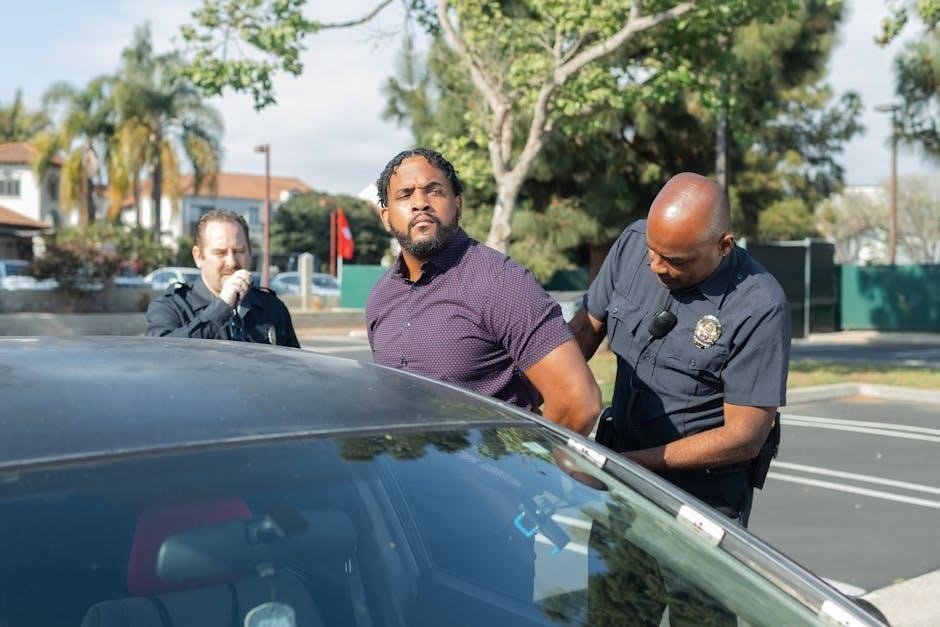Stephen Sterns was arrested and charged with the murder of Madeline Soto, facing additional counts of sexual abuse and possession of child pornography.
1.1 Overview of the Arrest Warrant
The arrest warrant for Stephen Sterns was issued in March 2024, following an investigation into the disappearance and death of 13-year-old Madeline Soto. The warrant alleged multiple charges, including murder, sexual battery, and possession of child pornography. It outlined the basis for Sterns’ arrest, detailing evidence obtained from his phone and Google Drive. The warrant also referenced a history of abuse allegations, with claims of misconduct dating back to 2022. This document served as the legal foundation for Sterns’ detention and the subsequent criminal proceedings. Its contents have been central to both the prosecution’s case and the defense’s motions to challenge evidence admissibility.
1.2 Background on Stephen Sterns and the Allegations
Stephen Sterns, a 37-year-old Florida man, was identified as the primary suspect in the disappearance and death of Madeline Soto, his girlfriend’s 13-year-old daughter. The allegations against Sterns include murder, sexual battery, and possession of child pornography. Investigative findings suggest a pattern of abuse, with claims dating back to 2022 when Madeline was 11. Sterns’ arrest followed the recovery of digital evidence from his phone and Google Drive, which prosecutors allege contains incriminating material. His defense has since filed motions challenging the legality of the searches and the admissibility of the evidence. Sterns remains in custody as the case progresses through the judicial system.

The Arrest Warrant Details
Stephen Sterns faced two arrest warrants: one issued on February 28, 2024, for sexual battery and child pornography, and another on March 4, 2024, alleging abuse since 2022.
2.1 When Was the Arrest Warrant Issued?
The first arrest warrant for Stephen Sterns was issued on February 28, 2024, following allegations of sexual battery and possession of child pornography. This warrant was filed in response to evidence gathered by authorities during their investigation into Madeline Soto’s disappearance. A second warrant was issued on March 4, 2024, expanding the charges to include sexual abuse allegedly occurring since 2022, when Madeline was just 11 years old. These warrants marked significant developments in the case, leading to Sterns’ arrest and detention pending trial. The timing of these warrants underscores the ongoing nature of the investigation and the severity of the charges.
2.2 Charges Listed in the Arrest Warrant
Stephen Sterns faces multiple serious charges, including first-degree murder for the death of Madeline Soto, sexual battery, and possession of child pornography. The arrest warrant details 60 counts of child sexual abuse, alleging offenses that began in 2022 when Madeline was 11 years old. These charges reflect the severity of the allegations and the extensive evidence collected by investigators. The warrant also highlights the digital evidence obtained from Sterns’ phone and Google Drive, which prosecutors argue contains material relevant to the charges. The combination of murder and sexual abuse charges underscores the complexity and gravity of the case against Sterns.

Legal Challenges and Motions
Stephen Sterns’ defense filed motions to suppress evidence obtained without a warrant and sought to delay court hearings, challenging the admissibility of sexual abuse evidence.
3.1 Defense Motions to Suppress Evidence
The defense argued that evidence from Stephen Sterns’ phone and Google Drive should be suppressed, claiming police lacked a warrant for the search. They maintained that without proper authorization, the digital evidence was obtained unlawfully and should not be admitted in court. This motion aimed to exclude potentially incriminating material, asserting violations of Sterns’ privacy rights. The case highlighted legal debates surrounding digital searches and the necessity of warrants in modern investigations. The defense’s strategy focused on undermining the prosecution’s key evidence, potentially impacting the trial’s outcome significantly.
3.2 The Issue of Search Warrants for Digital Evidence

The case raised significant questions about the legality of digital evidence searches. Stephen Sterns’ defense argued that police accessed his phone and Google Drive without obtaining a proper search warrant, violating his privacy rights. This issue sparked debate over the application of traditional warrant requirements to modern digital investigations. The defense contended that digital evidence should be excluded due to the lack of a warrant, potentially weakening the prosecution’s case. The controversy highlighted the challenges of balancing privacy protections with law enforcement’s need to access digital data in criminal investigations, particularly in cases involving severe allegations like murder and child abuse.

The Case of Madeline Soto

Madeline Soto, a 13-year-old girl, tragically lost her life under disturbing circumstances. Her case led to severe charges against Stephen Sterns, including murder and sexual abuse.
4.1 The Tragic Circumstances of Her Death
Madeline Soto, aged 13, died under deeply disturbing conditions. Her disappearance and subsequent death led to Stephen Sterns’ arrest. Evidence from his phone and Google Drive revealed severe sexual abuse allegations. The arrest warrant detailed charges of murder, sexual battery, and child pornography possession, highlighting the gravity of the case. Legal motions by Sterns’ defense have focused on suppressing this digital evidence, arguing police lacked proper warrants. The case has sparked public outrage and extensive media coverage.
4.2 Evidence Obtained from Stephen Sterns’ Phone and Google Drive
Evidence from Stephen Sterns’ phone and Google Drive proved critical in linking him to Madeline Soto’s death. Investigators uncovered disturbing content, including photos and messages, suggesting prolonged abuse. The data revealed a timeline of alleged sexual exploitation, starting when Madeline was 11. Sterns’ defense argued that police lacked proper warrants to search his digital accounts, leading to motions to suppress this evidence. Despite these legal challenges, the material remains central to the prosecution’s case, detailing graphic interactions and alleged crimes. The evidence paints a harrowing picture of Madeline’s final years, forming the basis for the charges against Sterns.

Key Motions Filed by the Defense
Stephen Sterns’ defense filed motions to delay the court hearing and challenge the admissibility of sexual abuse evidence, arguing insufficient time to prepare and disputing evidence legality.
5.1 Motion to Delay the Court Hearing
Stephen Sterns’ legal team requested a delay in the court hearing, citing the need for additional time to review evidence and prepare their defense. The defense argued that the complexity of the case, including digital evidence from Sterns’ phone and Google Drive, required more time to analyze thoroughly. This motion was part of a broader strategy to ensure the defense had adequate preparation to address the charges effectively; The prosecution opposed the delay, emphasizing the need for a timely resolution, but the court’s decision remains pending.
5.2 Challenging the Admissibility of Sexual Abuse Evidence

Stephen Sterns’ defense team filed a motion to exclude sexual abuse evidence, arguing it was obtained without proper consent or warrants. They contended that authorities lacked legal justification to access Sterns’ digital devices, where the evidence was found. The defense emphasized that admitting such evidence would violate Sterns’ constitutional rights, potentially tainting the trial’s fairness. This challenge aimed to undermine the prosecution’s case by questioning the legality of evidence collection methods. If successful, it could significantly impact the trial’s outcome, as much of the case relies on digital evidence tied to the abuse allegations against Sterns.

Recent Developments in the Case
Recent developments include jail calls revealing Sterns’ communication with family and heightened public scrutiny amid ongoing media coverage of the case.

6.1 Jail Calls and Communication with Family
Recent jail calls reveal Stephen Sterns communicating with his family, expressing emotional distress and discussing the case. These calls provide insight into his mental state and family dynamics. Sterns claimed he accidentally factory-reset his phone the day Madeline went missing, potentially destroying evidence. His attorneys argue this supports their motion to suppress digital evidence obtained without a warrant. The calls also highlight the emotional toll on Sterns’ family, particularly his parents, who appear to be struggling with the allegations against their son. These recordings have become a focal point in the case, offering a personal perspective on the legal battle unfolding in court.
6.2 Public Reaction and Media Coverage
The case of Stephen Sterns has sparked widespread public outrage and intense media scrutiny. Local news outlets, such as WESH, have provided extensive coverage, highlighting the tragic death of Madeline Soto and the serious charges against Sterns. The community remains deeply affected by the allegations, with many calling for justice for the victim. Media reports have also focused on the defense’s motions, particularly the challenge to the admissibility of evidence obtained from Sterns’ phone and Google Drive. Public reaction has been vocal, with many expressing strong opinions on social media and in local forums. The case continues to dominate headlines as it progresses through the legal system.

